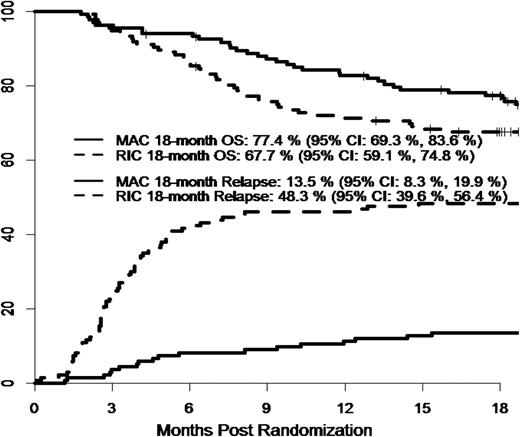Abstract
Although reduced intensity conditioning (RIC) has a lower toxicity profile and lower treatment related mortality (TRM), retrospective analyses have shown higher relapse rates and similar overall survival (OS) when compared to myeloablative (MAC) regimens in patients with myeloid malignancies. The BMT CTN performed a phase III randomized trial to compare outcomes by conditioning intensity in patients with MDS (N=54) or AML (N=218) (18-65 years, HCT-specific comorbidity index score ≤ 4) who had < 5% marrow myeloblasts by morphology at time of pre-transplant assessment. The primary endpoint of the study was 18 month post-randomization overall survival (OS). Secondary endpoints included: relapse free survival (RFS), relapse rates, TRM, graft-versus-host disease (GVHD), and quality of life (QOL). The RIC regimens were fludarabine (120-180 mg/m2) with busulfan (≤ 8 mg/kg oral or IV equivalent) (Flu/Bu, N=110) or melphalan (< 150 mg/m2) (FM, N=27). The MAC regimens were busulfan (16 mg/kg oral or 12.8 mg/kg IV) with cyclophosphamide (120 mg/kg) (Bu/Cy, N=40); or fludarabine (120-180 mg/m2) (Bu/Flu, N=87); or, cyclophosphamide (120 mg/kg) and total body irradiation (1200-1420cGy) (CyTBI, N=8). The planned enrollment was 356 patients; however, accrual was stopped early due to a presumed benefit of MAC as assessed by an independent DSMB safety review. Among 272 patients enrolled, 135 received MAC and 137 received RIC regimens. Seven enrolled patients did not receive a transplant (RIC N=4, MAC N=3) mainly due to relapse. Most (80.3%) patients randomized to RIC received a busulfan-based regimen. At 18 months, OS for patients on the RIC arm was 67.7% (95%CI 59.1-74.8%) versus 77.4% (95%CI 69.3-83.6%) on the MAC arm, based on intention-to-treat analysis. Although survival was higher with MAC, the difference was not statistically significant (difference of 9.7%, 95% CI -0.9-20.3%, p=0.07). Grade II-IV acute GVHD through 100 days was 31.6% on the RIC arm versus 44.7% on the MAC arm, p=0.024. TRM on the RIC arm was 4.4% (95%CI 1.8-8.9%) versus 15.8% (95%CI 10.2-22.6%) on the MAC arm, p=0.02. Relapse on the RIC arm was 48.3% (95%CI 39.6-56.4%) versus 13.5% (95%CI 8.3-19.9%) on the MAC arm, p<0.01. RFS for patients on the RIC arm was 47.3% (95%CI 38.7-55.4%) versus 67.7% (95%CI 59.0-74.9%) on the MAC arm and the difference was statistically significant (difference of 20.4%, 95%CI 8.8-31.9%, p<0.01). Among patients randomized to RIC, 44 died; relapse was the primary cause of death (86.4%). Among patients randomized to MAC, 31 died; GVHD was the primary cause of death (51.6%) followed by relapse (32.2%). QOL was assessed as a secondary endpoint in this trial using FACT and SF36 tools. Better QOL was observed at day 100 and one year with RIC, particularly regarding physical components with fewer differences in mental and social components.
No relevant conflicts of interest to declare.
Author notes
Asterisk with author names denotes non-ASH members.


This feature is available to Subscribers Only
Sign In or Create an Account Close Modal